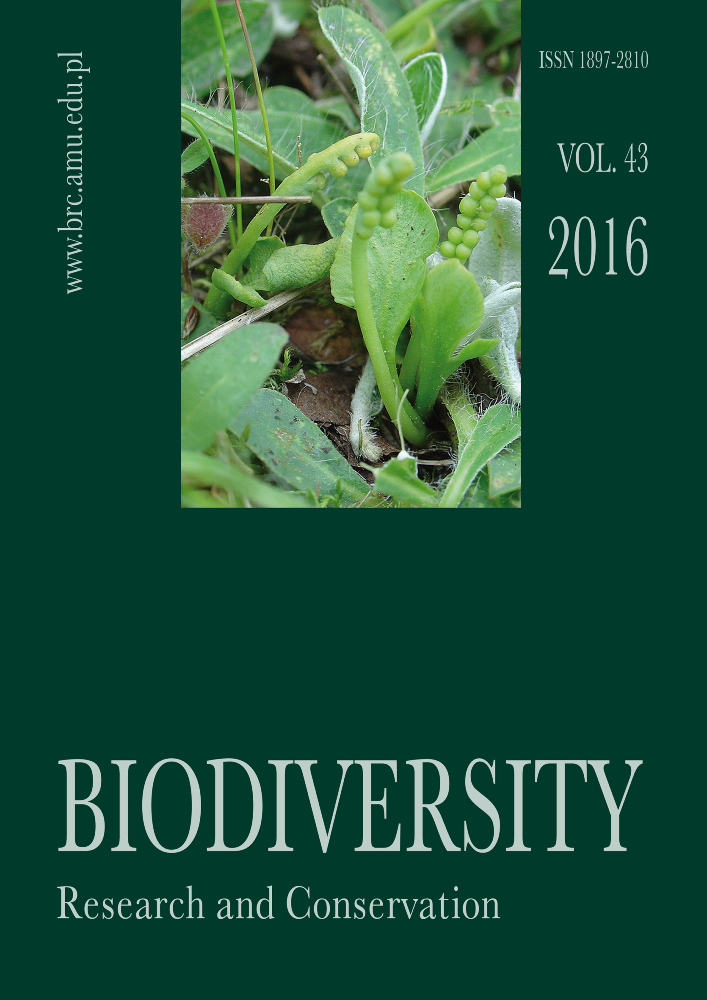Abstract
This paper provides a list of intracellular isozyme systems of Trichaptum abietinum (J. Dicks.) Ryvarden (Basidiomycetes) that can be used for population studies. Population structure of the fungus within the Carpathian National Nature Park (CNNP) was established. Percent of polymorphic loci in general was 83.3%. Groups of rare alleles were assigned Sod88, Sod138, Sdh191, and Est111. Calculated Wright's fixation index allowed establishing privilege of the heterozygotes on locus Acp and homozygotes on locus Sod. The population of T. abietinum in the CNNP was in equilibrium state.
References
Annesi T., Coppola R. & Motta E. 2003. Isozyme analysis on some wood decay fungi. Journal of Plant Pathology 85: 87-90.
Baldrian P. 2008. Enzymes of saprotrophic basidiomycetes. In: L. Boddy, J. C. Frankland & P. van West (eds.). Ecology of Saprotrophic Basidiomycetes, pp. 19-41. Academic Press, Amsterdam.
Berg E. E. & Hamrick J. L. 1997. Quantification of genetic diversity at allozyme loci. Can. J. For. Res. 27: 415-424.
Bilay V. I. 1982. Metodyi eksperimentalnoy mikologii. Naukova dumka, Kyiv.
Boddy L., Frankland J. & West P. 2008. Ecology of saprotrophic Basidiomycetes. 372 pp. Published by Elsevier Ltd.
Boiko S. M. 2015. Allozyme polymorphism in mono- and dikaryotic cultures of fungus Schizophyllum commune Fr. (Basidiomycetes). Cytology and Genetics 49: 27-31.
Bonde M. R., Micales J. A. & Peterson G. L. 1993. The use of isozyme analysis for identification of plant-pathogenic fungi. Plant Disease 77: 961-968.
Bragaloni M., Anselmi N. & Cellerino G. P. 1997. Identification of European Armillaria species by analysis of isozyme profiles. European Journal of Forest Pathology 27: 147-157.
Eichlerova I., Homolka L., Zifcakova L., Lisa L., Dobiasova P. & Baldrian P. 2015. Enzymatic systems involved in decomposition reflects the ecology and taxonomy of saprotrophic fungi. Fungal ecology 13: 10-22.
Engh I. B., Carlsen T., Kauserud H., Hogberg N., Saetre G.-P. & Doi S. 2010. Two invasive populations of the dry rot fungus Serpula lacrymans show divergent population genetic structures. Mol. Ecol. 19: 706-715.
Gorova T. L. 1980. Macromycetes derivatives spruce Ukrainian Carpathians. Ukr. Bot. J. 37: 44-50 (in Ukraine with English summary).
Grand L. F., Vernia C. S. & Munster M. J. 2009. Biogeography and hosts of poroid wood decay fungi in North Carolina: species of Trametes and Trichaptum. Mycotaxon 106: 243-246.
Hames B. D. 1998. Gel Electrophoresis of Proteins: A Practical Approach 3rd ed. 352 pp. Oxford University Press, New York.
Hogberg N, Holdenreider O. & Stenlid J. 1999. Population structure of the wood decay fungus Fomitopsis pinicola. Heredity 83: 354-360.
Huang H., Dane F. & Kubisiak T. 1998. Allozyme and RAPD analysis of the genetic diversity and geographic variation in wild populations of the American chestnut (Fagaceae). Am. J. Bot. 85: 1013-1021.
James T. Y., Porter D., Hamrick J. L. & Vilgalys R. 1999. Evidence for limited intercontinental gene flow in the cosmopolitan mushroom Schizophyllum commune. Evolution 53: 1665-1677.
Jasalavich C. A., Ostrofsky A. & Jellison J. 2000. Detection and identification of decay fungi in spruce wood by restriction fragment length polymorphism analysis of amplified genes encoding rRNA. Applied and environmental microbiology 66: 4725-4734.
Kauserud H. & Schumacher T. 2003a. Ribosomal DNA variation, recombination and inheritance in the basidiomycete Trichaptum abietinum: implications for reticulate evolution. Heredity 91: 163-172.
Kauserud H. & Schumacher T. 2003b. Regional and local population structure of the pioneer wood-decay fungus Trichaptum abietinum. Mycologia 95: 416-425.
Manchenko G. P. 2003. Handbook of detection of enzymes on electrophoretic gels. 553 pp. CRC Press.
Mishra A. K., Sharma K. & Misra R. S. 2010. Isozyme and PCR-based genotyping of epidemic Phytophthora colocasiae associated with taro leaf blight. Archives of Phytopathology and Plant Protection 43: 1367-1380.
Mondini L., Noorani A. & Pagnotta M. 2009. Assessing plant genetic diversity by molecular tools. Diversity 1: 19-35.
Nei M. 1978. Estimation of average heterozygosity and genetic distance from a small number of individuals. Genetics 89: 583-590.
Osono T. & Takeda H. 2006. Fungal decomposition of Abies needle and Betula leaf litter. Mycologia 98: 172-179.
Otieno O. D., Onyango C., Onguso J. M., Matasyoh L. G., Wanjala B. W., Wamalwa M. & Harvey J. J. 2015. Genetic diversity of Kenyan native oyster mushroom (Pleurotus). Mycologia 107: 32-38.
Ovaskainen O., Schigel D., Ali-Kovero H., Auvinen P., Paulin L., Norden B. & Norden J. 2013. Combining high-throughput sequencing with fruit body surveys reveals contrasting life-history strategies in fungi. ISME Journal 7: 1696-1709.
Runnel K., Tamm H. & Lohmus A. 2015. Surveying wood-inhabiting fungi: Most molecularly detected polypore species form fruit-bodies within short distances. Fungal Ecology 18: 93-99.
Shnyreva A. V. Belokon Yu. S., Belokon M. M. & Altukhov Yu. P. 2004. Interspecific genetic variability of the Oyster mushroom Pleurotus ostreatus as revealed by allozyme gene analysis. Russian Journal of Genetics 40: 871-881.
Siddiquee S., Abdullah F., Guan T. S. & Rohaza E. 2007. Level in allozyme variations of Malaysian isolates of Trichoderma harzianum and its taxonomic implications. Research journal of microbiology 10: 717-726.
Siddiquee S., Guan T. S. & Kalsom Y. 2010. Isozyme analysis and relationships among three species in Malaysian Trichoderma isolates. J. Microbiol. Biotechnol 20: 1266-1275.
Stenlid J., Karlsson J. O& Hogberg N. 1994. Intraspecific genetic variation in Heterobasidion annosum revealed by amplification of minisatellite DNA. Mycol. Res. 98: 57-63.
Udu-Ibiam O. E., Ogbu O., Ibiam U. A., Nnachi A. U., Agah M. V., Ukaegbu C. O., Chukwu O.S., Agumah N. B. & Ogbu K. I. 2014. Phytochemical and antioxidant analyses of selected edible mushrooms, ginger and garlic from Ebonyi State, Nigeria. IOSR Journal of Pharmacy and Biological Sciences 9: 86-91.
Xin Qian, Cai-xia Wang & Min Tian. 2013. Genetic diversity and population differentiation of Calanthe tsoongiana, a rare and endemic orchid in China. Int. J. Mol. Sci. 14: 20399-20413.
Yeh F. C., Yang R. & Boyle T. 1999. POPGENE Version 1.32. Microsoft window-based freeware for population genetic analysis. Univ. Alberta. Center Intern. Forestry Res.
Zjawiony J. K. 2004. Biologically active compounds from Aphyllophorales (Polypore) fungi. J. Nat. Prod. 67: 300-310.




